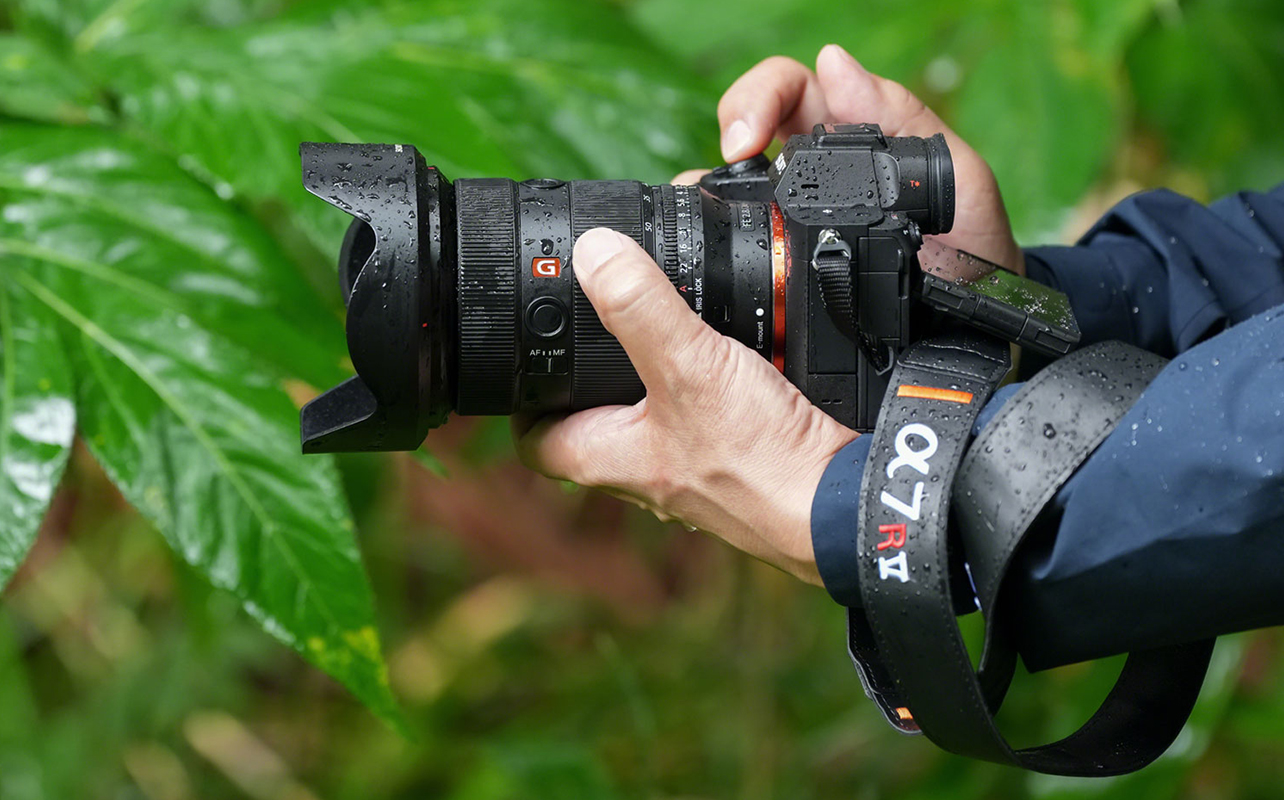
So, you’ve decided to get serious about your photography or video content—great move! But now you’re faced with a big question: mirrorless vs DSLR—which one’s right for you? It’s a common dilemma, especially for content creators diving into the world of higher-end cameras. Choosing the right camera can directly impact how smoothly you capture content, how mobile you can be on shoots, and how effectively you handle both photo and video work. Whether you’re creating social media reels, professional wedding albums, or YouTube vlogs, your gear should elevate your vision—not limit it.
In this post, we’ll break down the details that set these two apart, like image quality, autofocus, battery life, and make recommendations based on your skill level and shooting style. Whether you’re a beginner, a hybrid shooter, or gearing up for YouTube fame, we’ll help you make a confident choice.
What is a mirrorless camera?
A mirrorless camera may look like a DLSR, but the “mirrorless” part refers to the fact there is no mirror mechanism inside. Instead of reflecting light up into an optical viewfinder, the image is sent directly to a digital sensor, which then displays a real-time preview on the screen or electronic viewfinder.
This allows for more compact builds in different sizes, including a range of tech-friendly features that have made mirrorless cameras increasingly popular.
Key features of mirrorless cameras
- Compact design: No mirror = fewer moving parts and lighter, smaller camera bodies. Perfect for travel and on-the-go shoots.
- Faster autofocus: Most mirrorless systems use on-sensor phase-detection autofocus, which is often faster and more accurate—especially during video recording or live view.
- Real-time image preview: What you see is (almost exactly) what you get. Exposure, white balance, and depth of field are displayed in real time on the LCD or EVF.
A cutaway look at DSLR and mirrorless cameras
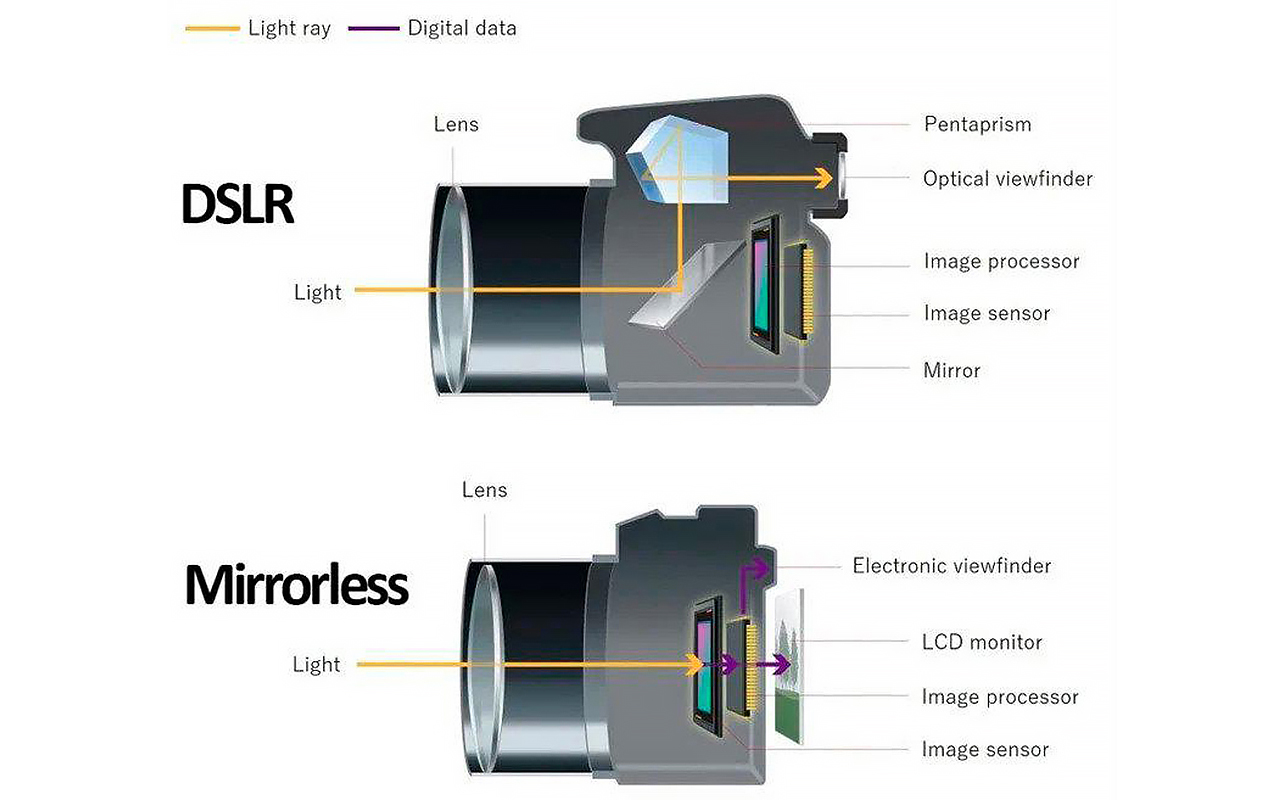
What is a DSLR camera?
DSLR stands for Digital Single-Lens Reflex. These cameras use a mirror inside the body to reflect light from the lens up into an optical viewfinder. When you press the shutter, the mirror flips up, exposing the sensor to light and capturing the photo. It’s a tried-and-true system that’s been the go-to for professionals for decades going back to film photography.
Key features of DSLR cameras
- Reliable optical viewfinder: No screen lag here—what you see through the viewfinder is a pure optical image.
- Longer battery life: Fewer electronic components constantly running allow DSLRs to often outlast mirrorless models on a single charge.
- Extensive lens options: DSLR systems, especially from brands like Canon and Nikon, have had decades to build robust, diverse lens ecosystems.
Mirrorless vs DSLR: key differences
Now that we’ve covered the basics, let’s dive into the difference between mirrorless and DSLR cameras that really matter to content creators.
Weight and portability
Mirrorless cameras tend to be smaller and lighter—great for travel, vlogging, or all-day shoots where weight matters. DSLRs, on the other hand, are bulkier and more rugged, which some photographers still prefer for grip and balance, especially with long camera lenses.
Autofocus and speed
Autofocus performance is a hot topic between mirrorless vs DSLR models, and mirrorless cameras now generally outperform DSLRs in this area. That’s especially true for video or subject tracking, where eye detection, face detection, and real-time tracking have improved dramatically. Sony has long been a leader in that regard, though competing models like the Canon EOS R series or Nikon Z series are gaining ground.
Battery life and durability
DSLRs still win in battery life. If you’re out in the wild shooting landscapes or spending hours in a studio, you’ll appreciate not having to change batteries often. That said, it’s not hard to swap out batteries in mirrorless cameras. As for durability, both camera types can be built like tanks, but DSLRs have fewer electronic components, which can be beneficial in extreme conditions.
Pros and cons of mirrorless cameras
Mirrorless cameras are a top pick for creators who want portability, speed, and high-end features. They’re especially good for hybrid shooters doing both photo and video, and those into vlogging or street photography.
Pros:
- Lightweight and compact: Some mirrorless cameras, especially those specializing in vlogging, can be considerably smaller than DSLRs, making them ideal for travel or handheld shooting for extended periods.
- Silent shooting options: Many mirrorless models offer electronic shutters, letting you shoot in complete silence, perfect for weddings, wildlife, or documentary filming.
- Advanced autofocus, especially for video: On-sensor autofocus systems are incredibly fast and accurate, with features like real-time eye tracking that are great for moving subjects.
- Live exposure preview in real time: You can see exactly what your image will look like before pressing the shutter, reducing guesswork and wasted shots.
Cons:
- Shorter battery life: Electronic viewfinders and constant LCD use drain batteries faster than optical systems, often requiring you to carry spares.
- Fewer native lenses for newer systems (though this is improving quickly): Although mirrorless lens ecosystems are growing, some brands still lag behind DSLR counterparts in lens variety—especially budget-friendly options.
- Can be more expensive on average for equivalent performance: Entry-level mirrorless cameras tend to be priced higher than comparable DSLRs, especially when factoring in newer lens mounts.
Pros and cons of DSLR cameras
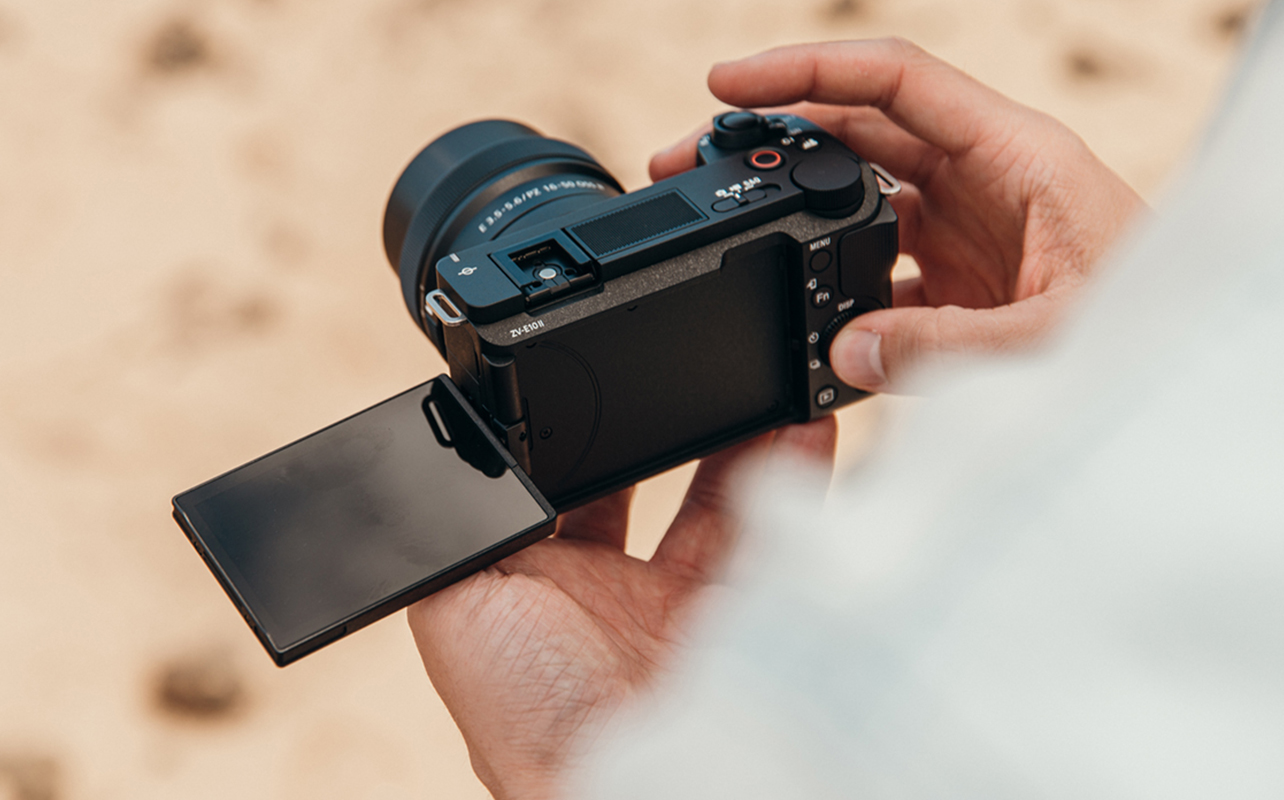
DSLRs still have a strong following among professional photographers and traditionalists. If you’re into event photography, studio portraits, or wildlife, you might still prefer the tactile feel and optical precision of a DSLR.
Pros:
- Outstanding battery life: Without digital displays constantly drawing power, DSLRs usually last for 1,000+ shots per charge—ideal for long sessions or remote locations.
- Wide lens compatibility (especially for Canon and Nikon): DSLR systems boast decades of compatible lenses, from affordable entry-level options to high-end pro glass, so it’s easier to expand your kit affordably. That also includes adapters and converters for old school lenses from the film days.
- Rugged build and better handling for larger hands or gloves: DSLRs are generally more durable, with chunkier grips and sealed bodies that feel more secure in rough weather or studio setups.
- Optical viewfinder with no lag: What you see is exactly what the lens sees—no digital lag, which some photographers still prefer for accuracy and eye comfort.
Cons:
- Heavier and bulkier: The mirror and prism system adds size and weight, which can be tiring for handheld or mobile shooting. Plus, a DSLR takes up more space when commuting or travelling.
- Slower autofocus in live view or video mode: DSLRs rely on contrast-detection for autofocus during video or live view, which is often slower and less reliable than mirrorless alternatives.
- Not as future-proof (fewer new DSLR models being released): Most brands are shifting focus to mirrorless innovation, so future support, lens development, and firmware updates are dwindling for DSLRs.
Which one should you choose?
DSLR vs mirrorless for beginners? DSLR vs mirrorless for video? Time to get personal. The right camera isn’t just about specs; it’s also about your style, your workflow, and your creative goals. Let’s break it down by scenario.
Beginners
If you’re just starting out, mirrorless is generally the easier, more intuitive option. Features like live previews, touchscreens, and helpful guides built into the interface can shorten your learning curve. Models like the Canon EOS R50 or Nikon Z 50 are user-friendly, compact, and designed for those graduating to this level of photography.
Professionals
For studio work or wedding photography, DSLRs like the Canon EOS 5D Mark IV or Nikon D850 are workhorses. However, many pros are also switching to high-end mirrorless models like the Sony a9 II, Canon EOS R6 Mark II or Nikon Z 8 for their advanced autofocus and lighter weight.
Video-focused creators
Here’s where mirrorless wins big. From 4K recording at 60fps to incredible subject tracking, mirrorless models dominate the mirrorless vs DSLR debate over video. Canon mirrorless vs DSLR? Canon’s mirrorless lineup offers way more video-focused features like dual pixel AF and better codecs. Nikon mirrorless vs DSLR? The Nikon Z6 II is a game-changer for video compared to older Nikon DSLRs. This is even more evident when considering mirrorless cameras that lean heavily towards video, like the Sony Alpha ZV-E1, Fujifilm X100VI, and Canon PowerShot V1.
Hybrid shooters
If you’re doing both photos and videos—say, wedding shoots or YouTube content—mirrorless cameras offer better balance. They can handle both tasks well without the compromises typical of DSLRs when it comes to video. The Fujifilm X100VI and Canon PowerShot V1 are good examples of that.
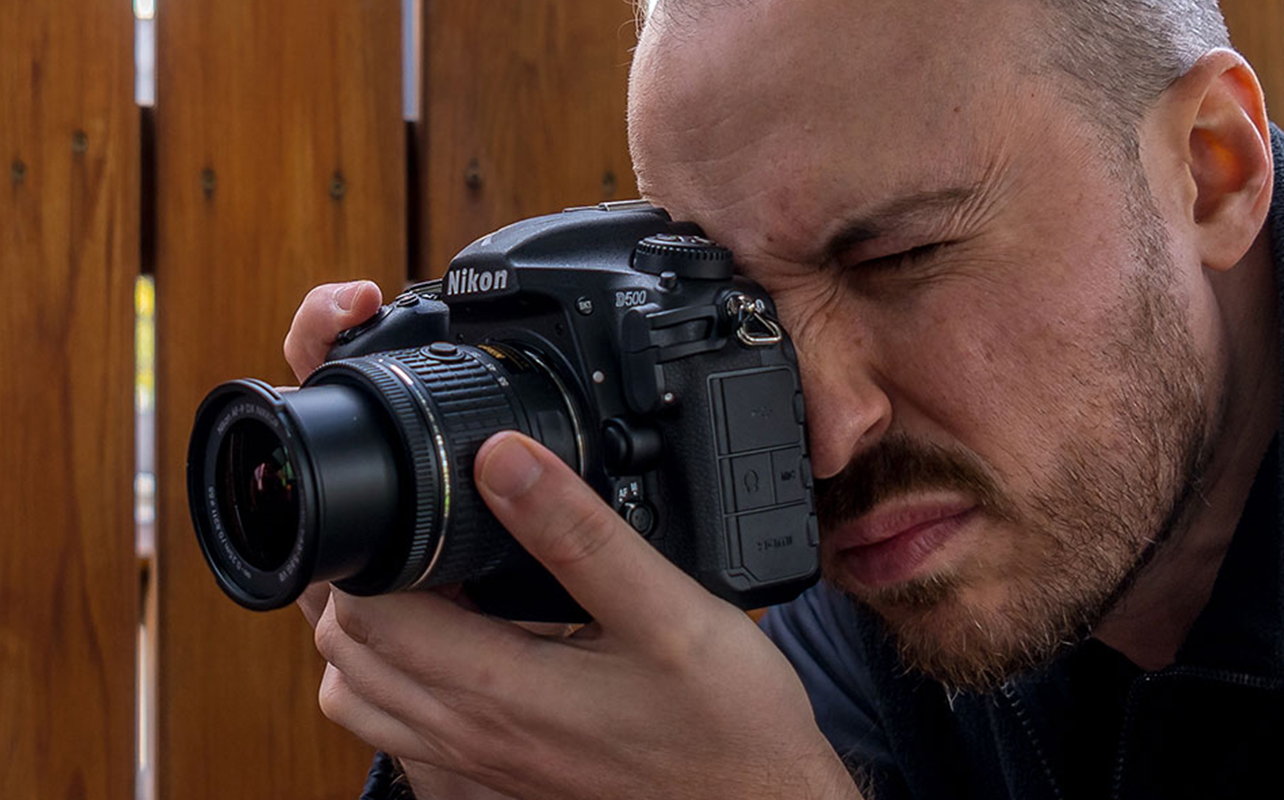
Mirrorless or DSLR? Which one should you choose?
Ultimately, the choice depends on your shooting style and priorities. If you’re focused on sharp 4K video, travel frequently, or love the convenience of modern features like smart autofocus and live previews, a mirrorless camera is likely your best bet. On the other hand, if you value long battery life, prefer the feel of an optical viewfinder, and want access to a mature lens ecosystem, a DSLR still delivers outstanding performance. While mirrorless systems are seeing the most innovation these days, DSLRs have lasting capabilities that make them reliable tools catering to specific needs. The key is to choose the system that helps you create more confidently and effectively—whether that’s capturing cinematic b-roll or timeless wedding portraits.
Still deciding between mirrorless and DSLR? Browse Best Buy’s expert-curated selection and find the perfect camera to match your photography or videography style.
This article was drafted using AI technology and then reviewed, fact-checked, and revised by a member of our editorial team.



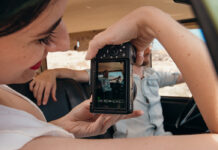

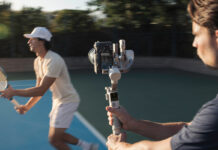
It’s going to be end of mine day, but before end I am reading this fantastic article to increase my know-how.